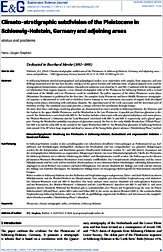| dc.contributor.author | Stephan, Hans-Jürgen | |
| dc.date.accessioned | 2014-03-19T11:08:27Z | |
| dc.date.available | 2014-03-19T11:08:27Z | |
| dc.date.issued | 2014-02-24 | |
| dc.identifier.citation | E&G – Quaternary Science Journal; Vol.63, No.1, p.3-18 | |
| dc.identifier.uri | http://hdl.handle.net/11858/00-1735-0000-0023-54C1-1 | |
| dc.description.abstract | In Schleswig-Holstein detailed petrographical and palynological studies were undertaken with samples from exposures and core drillings examined over the last four decades. Analyses of the gravel fraction and ‘indicator rocks’ of glacial deposits were used for stratigraphical interpretations and correlation. Glaciofluvial sediments were dated by TL and OSL. Combined with the stratigraphical information from organic deposits, a new climato-stratigraphic table of the Pleistocene for Schleswig-Holstein with a revised subdivision of the Middle and Late Pleistocene could be established. The pollen sequence of the oldest Pleistocene warm phase (Warmhörn-Thermomer) is published for the first time. The complete Early Pleistocene and lower Middle Pleistocene stratigraphical sequence is documented at Lieth and at Gorleben (Lower Saxony) in two continuous successions of organic beds developed during warm phases alternating with cold phase deposits. The uppermost part of the Lieth succession and the lowermost part of Gorleben overlap. The combined succession provides a unique reference for correlations through Europe.
No more than three cold stages involving glaciation are demonstrated to exist currently in Schleswig-Holstein, the Elsterian and the Saalian in the upper Middle Pleistocene, and the Weichselian in the Late Pleistocene. A possible pre-Elsterian glaciation is discussed. The Holsteinian is correlated with MIS 9e. The Saalian includes a lower part with non-glacial cold phases and warm phases, the ‘Wacken-Warmzeit’ (=Dömnitz) and the ‘Leck-Warmzeit’ correlated with MIS 7e and MIS 7c respectively, and a glacial upper part. During the Weichselian probably two phases of glaciation existed, the first in the early Middle Weichselian (‘Ellund-Phase’; late MIS 4 or/and the early MIS 3), the second in the Upper Weichselian (MIS 2). The Weichselian glaciation of Schleswig-Holstein ends around 15 ka BP when huge stagnant and dead ice masses of the Young Baltic glacier advance (‘Mecklenburg-Phase’) melted. | |
| dc.language.iso | eng | |
| dc.publisher | Geozon Science Media | |
| dc.relation.ispartofseries | E&G | |
| dc.subject.ddc | 551 | |
| dc.title | Climato-stratigraphic subdivision of the Pleistocene in Schleswig-Holstein, Germany and adjoining areas | |
| dc.type | article | |
| dc.bibliographicCitation.volume | 63 | |
| dc.bibliographicCitation.issue | 1 | |
| dc.bibliographicCitation.firstPage | 3 | |
| dc.bibliographicCitation.lastPage | 18 | |
| dc.identifier.doi | 10.23689/fidgeo-1951 | |
| dc.type.version | Verlagsversion | |
| dc.rights.holder | Geozon Science Media | |
| dc.date.updated | 2014-03-19T11:08:27Z | |
| dc.subject.free | pleistocene | |
| dc.subject.free | schleswig-holstein | |
| dc.subject.free | pléistocène | |
| dc.subject.free | correlations | |
| dc.subject.free | climato-stratigraphic table | |
| dc.relation.volume | E&G – Quaternary Science Journal; Vol.63 | |
| dc.bibliographicCitation.journal | E&G | |
| dc.relation.collection | Geologische Wissenschaften | |
| dc.description.type | research | |


